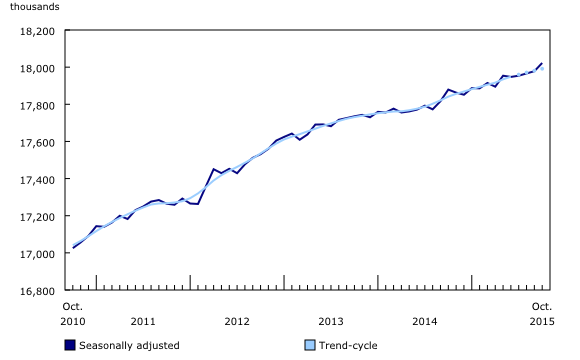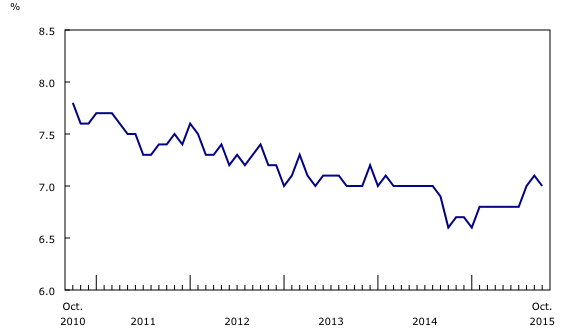Labour Force Survey, October 2015
Archived Content
Information identified as archived is provided for reference, research or recordkeeping purposes. It is not subject to the Government of Canada Web Standards and has not been altered or updated since it was archived. Please "contact us" to request a format other than those available.
Released: 2015-11-06
After four months of little change, employment increased by 44,000 (+0.2%) in October, bringing the number of people employed in Canada to over 18 million for the first time. The unemployment rate declined by 0.1 percentage points to 7.0%.
Compared with 12 months earlier, employment was up 143,000 (+0.8%), with all of the gains in full-time work. During the same period, the total number of hours worked grew by 0.7%.
In October, employment increased for women aged 55 and older and fell among women aged 25 to 54. There was little change for the other demographic groups.
Ontario, British Columbia, New Brunswick and Manitoba saw gains in employment, while Alberta recorded a decline. There was little or no change in the other provinces.
In October, more people were employed in public administration, wholesale and retail trade, as well as accommodation and food services. On the other hand, employment decreased in the 'other services' industry, natural resources and utilities.
Both the private and public sectors saw an increase in the number of employees in October, while the number of self-employed workers decreased.
More women aged 55 and older working
In October, employment increased by 44,000 for women aged 55 and older and their unemployment rate fell from 5.4% to 5.0%. Compared with 12 months earlier, employment for this group was up 92,000 (+5.8%), partly the result of growth in their population.
Among men aged 55 and older, employment was little changed in October, but the unemployment rate dropped 0.7 percentage points to 5.7% as fewer of them looked for work.
Employment for women aged 25 to 54 fell by 30,000 in October and their unemployment rate rose from 5.5% to 5.7%. On a year-over-year basis, employment for this group was little changed.
For men aged 25 to 54, employment was little changed in October but was up 29,000 on a year-over-year basis. Compared with October 2014, their unemployment rate rose from 5.8% to 6.4%, the result of an increase in the number of people searching for work.
Employment among youths aged 15 to 24 was little changed and their unemployment rate was 13.3%. In the 12 months to October, youth employment was down 45,000 (-1.8%). Over the same period, the population of this group declined by 41,000 (-0.9%).
Employment gains in several provinces
In Ontario, employment increased by 29,000 in October and the unemployment rate was 6.8%. On a year-over-year basis, employment in the province was little changed as gains in full-time work were offset by declines in part time.
Employment in British Columbia rose for the second consecutive month, up 23,000 in October. The unemployment rate was unchanged at 6.3% as more people participated in the labour market. With the recent increases, year-over-year employment gains in British Columbia amounted to 67,000 or 3.0%, the highest growth rate among the provinces.
In New Brunswick, 4,100 more people were employed in October. However, the unemployment rate was little changed at 9.0%, reflecting an increase in labour market participation.
Employment in Manitoba rose for the third consecutive month, up 2,800 in October, bringing employment gains over the past 12 months to 7,300 (+1.2%). With more people participating in the labour market, the unemployment rate held steady at 5.3%. Manitoba now has the lowest unemployment rate in the country, as the unemployment rates for Saskatchewan and Alberta increased in recent months.
Employment in Alberta fell by 11,000 in October and was little changed from 12 months earlier. Compared with October 2014, the participation rate increased by 0.6 percentage points to 73.1%. Over the same period, the unemployment rate in the province was up 2.2 percentage points to 6.6% as more people were looking for work.
In Saskatchewan, employment was virtually unchanged both in October and on a year-over-year basis. However, the unemployment rate increased by 0.5 percentage points to 5.6% in October, the result of more people searching for work.
Employment in Quebec was little changed in October, and the unemployment rate remained at 7.7%. On a year-over-year basis, employment in the province was up 47,000 (+1.2%), with all of the growth in the first four months of 2015.
Industry perspective
In October, employment increased by 32,000 in public administration. The increase was seen across all provinces and mostly in temporary work, coinciding with activities related to the recent federal election. Note that the Labour Force Survey reference week ran from October 11 to 17. Advanced polling took place from October 9 to the 12 and the election was held on October 19.
Employment in October also increased in wholesale and retail trade, up 18,000. On a year-over-year basis, however, employment in this industry was little changed.
Similarly, employment increased in accommodation and food services, up 13,000 in October, but it was little changed from 12 months earlier.
There were 8,900 fewer people working in 'other services' such as repair and maintenance, as well as personal and laundry services. In the 12 months to October, employment in this industry was down by 13,000 (-1.6%).
Employment in natural resources continued on the downward trend that began a year ago, falling by 8,000 in October and bringing total losses in the industry to 26,000 (-6.9%) over the past 12 months. Most of the declines were in Alberta.
In October, the number of employees increased by 41,000 in the private sector, and by 31,000 in the public sector. On the other hand, the number of self-employed workers was down 27,000.
Compared with 12 months earlier, the number of public sector employees was up 97,000 (+2.7%), while private sector employment was little changed. Self-employment was also little changed.
Note to readers
The Labour Force Survey (LFS) estimates for October are for the week of October 11 to 17.
The LFS estimates are based on a sample and are therefore subject to sampling variability. As a result, monthly estimates will show more variability than trends observed over longer time periods. For more information, see Interpreting Monthly Changes in Employment from the Labour Force Survey. Estimates for smaller geographic areas or industries also have more variability. For an explanation of sampling variability of estimates and how to use standard errors to assess this variability, consult the "Data quality" section of the publication Labour Force Information (71-001-X).
This analysis focuses on differences between estimates that are statistically significant at the 68% confidence level.
The employment rate is the number of employed persons as a percentage of the population 15 years of age and over. The rate for a particular group (for example, youths aged 15 to 24) is the number employed in that group as a percentage of the population for that group.
The unemployment rate is the number of unemployed as a percentage of the labour force (employed and unemployed).
The participation rate is the number of employed and unemployed as a percentage of the population.
For more detailed information, see the Guide to the Labour Force Survey (71-543-G).
Seasonal adjustment
Unless otherwise stated, this release presents seasonally adjusted estimates, which facilitates comparisons by removing the effects of seasonal variations. For more information on seasonal adjustment, see Seasonally adjusted data – Frequently asked questions.
Chart 1 shows trend-cycle data on employment. These data represent a smoothed version of the seasonally adjusted time series, which provide information on longer-term movements, including changes in direction underlying the series. These data are available in CANSIM table 282-0087 for the Canada-level employment series. For more information, see the StatCan Blog and Trend-cycle estimates – Frequently asked questions.
Sample redesign
Every 10 years, the LFS undergoes a sample redesign to reflect changes in population and labour market characteristics, as well as new definitions of geographical boundaries. The redesigned sample was introduced starting in January 2015 and was fully implemented in June 2015.
Next release
The next release of the LFS will be on December 4.
Products
A more detailed summary, Labour Force Information (71-001-X), is now available for the week ending October 17. From the Browse by key resource module of our website under Publications, choose All subjects then Labour.
Summary tables are now available online. From the Browse by subject module of our website, choose Labour.
With this release, eight new tables for the off-reserve Aboriginal population are now available in CANSIM. These tables provide annual data going back to 2007, and they are: 282-0226, 282-0227, 282-0228, 282-0229, 282-0230, 282-0231, 282-0232 and 282-0233.
Contact information
For more information, contact us (toll-free 1-800-263-1136; 514-283-8300; STATCAN.infostats-infostats.STATCAN@canada.ca).
To enquire about the concepts, methods or data quality of this release, contact Lahouaria Yssaad (613-951-0627; lahouaria.yssaad@canada.ca) or Andrew Fields (613-951-3551 andrew.fields@canada.ca), Labour Statistics Division.
- Date modified:





